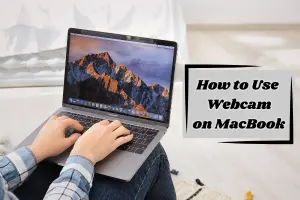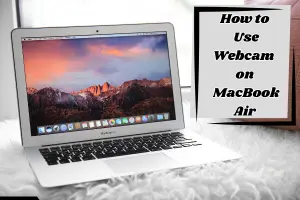How to Use External Webcam on Mac: Easy Setup & Troubleshooting Guide
Published: 9 Jan 2025
If you want to improve your video calls or streaming quality, using an external webcam on a Mac is a great idea. Mac’s built-in camera is okay for everyday use, but an external webcam can offer better quality, especially for professional meetings, content creation, and Zoom calls.
In this guide, I’ll show you how to use an external webcam on a Mac—from setting it up to fixing any problems that may arise. It’s a simple process, and I’ll make sure you complete it without any issues. So, let’s get started.
Choosing the Right External Webcam for Mac
The first step is selecting the right webcam that fits your requirements. Here’s how to make the best choice:
Key Features to Consider:
- Resolution: For a clear, sharp video, look for a webcam with at least 1080p Full HD resolution. Some high-end models offer 4K resolution for professional-level clarity.
- Wide-Angle Lens: A wider field of view is ideal for capturing more of the background or multiple people in the frame.
- Frame Rate: Choose a webcam with a higher frame rate (30 fps or 60 fps) to ensure smoother video, especially for streaming.
- Compatibility with macOS: Make sure the webcam is compatible with macOS. Popular brands like Logitech, Razer, and Elgato are known for their macOS-friendly drivers and software.
Popular Choices for Mac Users:
- Logitech C920/Brio: A reliable choice for 1080p or 4K video.
- Razer Kiyo Pro: Great for streaming with built-in lighting.
- Elgato Facecam: A high-quality option suitable for content creators.
| 🌟Tip: |
|---|
Check online reviews and compatibility forums to see how well a webcam works with your specific Mac model (e.g., MacBook Pro, iMac). |
3. How to Connect and Install an External Webcam on a Mac
Once you’ve chosen your webcam, setting it up is simple and quick. Here are the steps for different types of webcams:

For USB Webcams
Plug-and-play webcams make life easier. Follow these steps to connect this :
1. Plug the Webcam into a USB Port:
- Find an available USB port on your Mac.
- Connect the webcam to the port using the USB cable that came with it.
| 🌟Tip: |
|---|
If your Mac only has USB-C ports (like newer MacBook Air or Pro models), you’ll need a USB-to-USB-C adapter. These are small, affordable, and widely available online or in stores. |
2. Wait for Your Mac to Detect the Webcam:
- After plugging in the webcam, your Mac should automatically detect it.
- You might see a notification, or the webcam may show up in the system settings.
For Wireless Webcams:
Wireless webcams free you from cables. Follow these steps to connect one:
1, Turn on Bluetooth on Your Mac:
Make sure Bluetooth is enabled on your Mac by going to Apple Menu > System Preferences > Bluetooth and turning it on.
2. Follow the Pairing Instructions Provided with the Webcam:
- Read the user manual that came with your wireless webcam for specific instructions on how to pair it via Bluetooth or Wi-Fi.
Usually, you’ll need to put the webcam into pairing mode and wait for it to show up in your Bluetooth settings.
Testing the Webcam:
Once the webcam is connected, it’s important to make sure it works. Here’s how to test it:
Open FaceTime or Photo Booth:
- Go to Applications > FaceTime or Applications > Photo Booth.
These apps will automatically use the webcam once it’s properly connected.
If you need detailed steps to use Webcam on a Macbook Air, check out this guide:
👉 How to Use Webcam on Macbook Air
Ensure the Webcam is Selected:
- If the external webcam doesn’t show up automatically, go to System Preferences > Camera.
- Here, you can select the webcam you want to use if there are multiple options available.
Configuring External Webcam for Different Apps
Even after connecting your external webcam, some apps may still use your Mac’s built-in camera. Here’s how to change the camera settings in popular apps so you can switch to your external webcam.
How to Change Webcam on Mac:
1. Zoom:
Zoom is one of the most commonly used video conferencing apps. Here’s how to configure your camera.
- Open Zoom: Launch the Zoom app on your Mac.
- Go to Settings: In Zoom, click on your profile picture in the top-right corner and select Settings.
- Select the Video Settings: Under the Video tab, you’ll see a drop-down menu for selecting your camera.
- Choose Your External Webcam: From the list of available cameras, select your external webcam to switch to it.
2. FaceTime:
Facetime is perfect for one-on-one calls, Here’s how to configure your camera.
- Start a FaceTime Call: Open the FaceTime app and start a call.
- Select Video Settings:Once the call begins, click on Video in the top menu bar.
- Choose Your External Camera: In the drop-down menu, select your external webcam to switch from the built-in camera.
3. Skype:
Skype is another popular app where you can easily configure your camera.
- Open Skype: Launch the Skype app on your Mac.
- Go to Settings: Click on your profile picture in the top-left corner and select Settings.
- Select Audio & Video: In the Audio & Video section, you’ll find the camera settings.
- Choose Your External Webcam: Select your external webcam from the list of available cameras to switch to it.
4. Google Meet:
Google Meet is widely used for online meetings, and here’s how to configure your camera.
- Start a Google Meet Call: Go to Google Meet and start a video call.
- Open More Options: Click the three vertical dots in the top-right corner of the screen.
- Go to Settings: Choose Settings from the menu.
- Select Your External Camera: Under the Video tab, choose your external webcam from the list of available cameras.
By following these simple steps, you can easily switch to your external webcam in different apps. This ensures that your external webcam can be used for video calls and meetings without any problems.
If you need detailed steps to use Webcam on a Macbook Pro, check out this guide:
👉 How to Use Webcam on Macbook Pro
Troubleshooting External Webcam on Mac
Sometimes, you may encounter issues with your external webcam on Mac. Here are some common problems and solutions:
Mac Not Recognizing External Webcam
If your Mac isn’t detecting your external webcam so, try these solutions
- Solution 1: Restart Your Mac: Sometimes, simply restarting your Mac can resolve connection issues. Unplug the webcam, restart your Mac, and plug it back in.
- Solution 2: Update Software: Make sure that your macOS is up to date. Go to System Preferences > Software Update and install any pending updates.
- Solution 3: Check Permissions: Go to System Preferences > Security & Privacy and check the Camera section. Ensure that the apps you want to use with your webcam have permission to access the camera.
Poor Video Quality
If your external webcam provides poor video quality, try these solutions
- Solution 1: Adjust Lighting: If your video quality is poor, consider adding a light source near the webcam or using a webcam with built-in lighting.
- Solution 2: Update Webcam Drivers: Sometimes, the issue could be with outdated drivers. Make sure your webcam’s drivers are up to date. Visit the manufacturer’s website for updates.
Audio and Video Out of Sync
If you’re facing audio issues and video lag with an external webcam, try this solution
- Solution: This could be an issue with the video conferencing app. Try restarting the app or checking the audio settings within the app. You can also check for any updates for the app.
| 🌟Tip: |
|---|
Testing the webcam in multiple apps, like FaceTime, Skype, or Google Meet, can help you identify if the issue is with the webcam itself or specific to one app. This will help you to resolve issues more effectively. |
These fixes should help you solve the most common issues with your external webcam on your Mac. If the problem persists, so you should contact the webcam’s customer support.
Best Practices for Using an External Webcam
To get the most out of your external webcam, follow these tips for better performance and quality.
- Stable Positioning: Use a tripod or webcam mount to keep the camera steady. This prevents unstable video and unfavorable angles, giving you a more professional look.
- Eye Level Placement: Place the webcam at eye level for a natural and engaging video experience. This angle reflects in-person interaction and ensures proper framing.
- Good Lighting: Make sure there is enough light in the room. Use a ring light or natural light from a window to brighten your video.
- Background Setup: Keep your background clean and clutter-free. A simple backdrop helps the viewer focus on you.
- Regular Updates: Check for software updates for your webcam regularly. Updated drivers prevent compatibility issues and improve performance.
Following these best practices will improve video quality and ensure a smoother experience when using an external webcam.
Conclusion
I’m sure you now understand how to use an external webcam on a Mac and set it up properly. In this guide, I’ve covered everything from setting up your webcam to configuring it for apps like Zoom and FaceTime and troubleshooting common issues.
Whether you have a MacBook Air, MacBook Pro, or an iMac, these steps will make sure that your webcam works perfectly for you. An external webcam gives you clearer video, smoother streaming, and professional-quality calls, making it perfect for work, meetings, and content creation. If you’re looking to improve from your Mac’s built-in webcam, an external webcam is the best option. Install one today and take your video calls, meetings, and streaming to the next level!
FAQs
Here are answers to some of the most commonly asked questions about using an external webcam on a Mac.
How can I set my external webcam as the default on my Mac?
To make your external webcam the default, go to System Preferences > Camera and pick it as the primary option. In apps like Zoom or FaceTime, select the external webcam as your preferred device in the video settings. Most apps will remember your preference for future sessions.
Why isn’t my external webcam working on my Mac?
If your external webcam isn’t working, check the cable or Bluetooth connection and make sure it works with macOS. Restart your Mac, update the software, and give the app permission to use the camera under System Preferences > Security & Privacy. If that doesn’t fix it, try the webcam on a different app or device.
Do I need special software to use an external webcam on my Mac?
No, most external webcams are plug-and-play, and macOS will automatically recognize them. However, extra software from the manufacturer may provide additional features like advanced settings or filters.
How do I use an external webcam on a Mac?
Using an external webcam on a Mac is simple. Plug the webcam into a USB port (or connect through Bluetooth/Wi-Fi for wireless models), and your Mac should automatically detect it. Select the external webcam in the app’s video or camera settings to use it in apps.
How do I test if my external webcam is working?
You can test your webcam by opening apps like FaceTime or Photo Booth on your Mac. If the webcam doesn’t automatically appear, go to System Preferences > Camera to select it manually.

- Be Respectful
- Stay Relevant
- Stay Positive
- True Feedback
- Encourage Discussion
- Avoid Spamming
- No Fake News
- Don't Copy-Paste
- No Personal Attacks

- Be Respectful
- Stay Relevant
- Stay Positive
- True Feedback
- Encourage Discussion
- Avoid Spamming
- No Fake News
- Don't Copy-Paste
- No Personal Attacks





